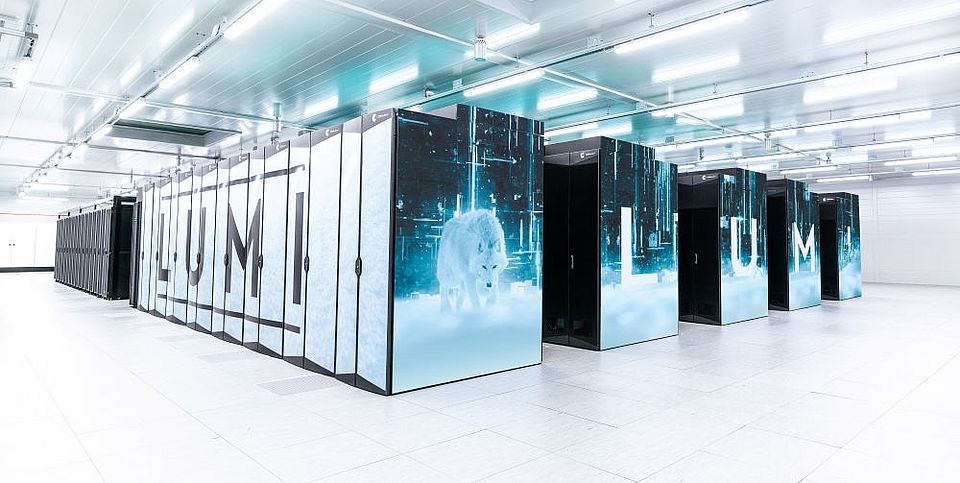/ Tanya Petersen
Swiss scientists win time on top European supercomputer
Scientists with the Square Kilometer Array Switzerland (SKACH) consortium will use the largest ever allocation of node hours on Europe’s LUMI-G supercomputer to conduct a simulation looking at the role of turbulence and gravity in the universe.
Scientists working with the Swiss arm of the international Square Kilometer Array Observatory (SKAO), the world’s largest and most sensitive radio observatory currently under construction, have been awarded 5.500.000 node hours, corresponding to 22 million GPU hours, on the LUMI supercomputer in Finland for 12-months. When they come online, SKAO telescopes will look at the history of the Universe as far back as the Cosmic Dawn, when the very first stars and galaxies formed.
With funding from the Platform for Advanced Scientific Computing and SERI as part of the SKACH consortium, the researchers have developed a leading-edge hydrodynamics code called SPH-EXA that is capable of simulating the behavior of fluids and plasmas on supercomputers, important because the universe consists mostly of gases and plasmas. Now, with the node hours awarded on Europe’s largest supercomputer, the code will create a simulation to investigate the formation of protostellar cores, the progenitors of stars like our own Sun.
“Understanding this will help us to know the distribution of masses of stars which has important implications for the observable properties of galaxies. The other thing we are hoping to do with this project is study mixing, that tries to uncover why there is an apparent homogeneity in stellar clusters which is not really well understood,” explained Rubén Cabezón, astrophysicist and scientific programmer at the Center for Scientific Computing (sciCORE) at the University of Basel, part of the SKACH team and principal investigator in SPH-EXA.
“This is equivalent to the largest turbulence simulation that has been ever done but for the first time we are including self-gravity, which is what we need for the stellar cores to collapse, and which is a major challenge, because it requires a lot of computational power to actually do the calculations with gravity,” he continued.
Another important element of the project is testing the code itself. Florina Ciorba is a Professor of High-Performance Computing at the University of Basel, also part of the SKACH team and principal investigator in SPH-EXA.
“I’ve dreamt of having access to such a huge machine allocation for an application and my objective is to see how the simulation behaves as a software code on that machine. I'm interested if there are any bottlenecks or inefficiencies in the way the simulation uses the system,” Ciorba explained. “Certain phenomena don't show at small scale but they will appear and be visible at large scale and I want to understand what happens in the time that we predicted the simulation will take.”
During its operation, the SKAO will collect unprecedented amounts of data, requiring the world’s fastest supercomputers to process this in near real time. This simulation experiment is helping to drive the development of codes, enhanced by High-Performance Computing and machine learning techniques, to handle these large data streams.
“With this code and the resolution that we can achieve thanks to the LUMI-G allocation, we can model interstellar turbulence using particle-based fluid dynamics, which has always been problematic in the past, and this is instrumental to be able to follow the formation of stars,” added Lucio Mayer, Head of the Institute for Computational Science at the University of Zurich also part of the SKACH team and principal investigator in SPH-EXA.
Those closely involved with the project, including Ralf Klessen, professor for theoretical astrophysics at Heidelberg University, a pioneer in computational astrophysics, believe its multi-disciplinary nature is a real strength. “Progress at the very forefront of science relies on bringing together expertise in many different research fields. In our case, the envisioned simulations and their adequate interpretation depend on input from computer science, applied mathematics and data analysis, as well as theoretical astrophysics and observational astronomy. This combination opens new pathways towards better understanding how star and star clusters form in the turbulent multi-phase interstellar medium in galaxies such as our Milky Way.”
Rubén Cabezón says the entire SPH-EXA team was ecstatic when they learned about the LUMI-G allocation, “There is so much science that can come from this, not only on astrophysics and cosmology, but also in computer science and this is what makes it so interesting. It's going to be a very, very exciting time.”
Developed for the EuroHPC Extreme Scale Allocation Call the LUMI-G allocation was awarded for the project: “TGSF: The Role of Turbulence and Gravity in Star Formation, Unveiling the sonic scale with Smoothed Particle Hydrodynamics".
The SKACH SPH-EXA team behind the proposal is:
Project management:
Lucio Mayer – PI, Cosmology, Computational Astrophysics, SPH specialist
Rubén Cabezón – Co-PI, Computational Astrophysics, SPH specialist, Developer of SPH-EXA
Florina Ciorba – Co-PI, Computer Science, High-Performance Computing, Load Balancing Specialist
Software development, Simulations & Data analysis:
Sebastian Keller – Computational Scientist, HPC, Developer of SPH-EXA
Osman Seckin Simsek – Computer Science, HPC, Developer of SPH-EXA
Jonathan Coles – Computational Scientist, Cosmology, Developer of SPH-EXA
Noah Kubli - Computational Astrophysics, Developer of SPH-EXA
Visualization & Data analysis:
Yiqing Zhu – Computational Science, Scientific and HPC visualization specialist
Jean Favre - Computational Science, Senior Visualization Software Engineer
Data management & Transfer, CI/CD & Testing:
Jean-Guillaume Piccinali – Computational scientist
Partners:
Ralf Klessen – Star Formation, Computational Astrophysics (Heidelberg University)
Domingo García-Senz – Computational Astrophysics, SPH specialist

